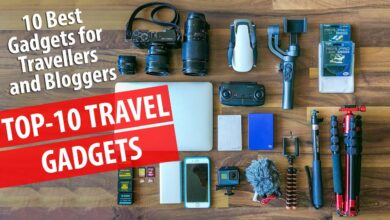
The guns and gadgets industry has experienced tremendous innovation and growth over the past decade. With advancements in materials and technology, manufacturers have developed cutting-edge firearms and accessories.
One area that has seen rapid development is precision rifles. New cartridge designs like 6.5 Creedmoor and .224 Valkyrie provide outstanding accuracy at extended ranges. Precision rifles now commonly feature modular chassis systems, adjustable stocks, and free-floating handguards. These innovations allow shooters to customize their rifle’s fit and function.
Handguns have also benefited from recent advancements. Polymer frame pistols like the Glock revolutionized the industry by being lightweight, durable, and reliable. Optics mounting systems allow hand gunners to equip miniature red dot sights for faster target acquisition. And suppressors help reduce noise and concussion.
The variety and quality of firearm accessories have drastically increased as well. Shooters can outfit their rifles with bipods, lasers, weapon lights, and high-end optics. Reloaders have access to progressive presses and tools to craft precision ammunition. Cutting-edge body armor provides lightweight and flexible protection.
The gun industry shows no signs of slowing innovation. As technology progresses, shooters gain access to better gear. This propels an ongoing cycle of manufacturers striving to design the next big breakthrough. The future looks bright for guns and gadgets.
Types of Guns
There are three major types of guns: handguns, rifles, and shotguns. Each has distinct features designed for different purposes.
Handguns
Handguns, also known as pistols, are designed to be fired while being held with one or two hands. There are two main types – revolvers and semi-automatic pistols.
Revolvers have a rotating cylinder that holds ammunition in separate chambers. When the trigger is pulled, the cylinder rotates and brings a new cartridge in line with the barrel for firing. Revolvers are typically limited to 5-6 shots before needing to be reloaded.
Semi-automatic pistols have a magazine that stores multiple cartridges and feeds them into the chamber one by one with each trigger pull. This allows for greater ammunition capacity than revolvers. Popular models of semi-auto pistols include the 1911, Glock, and Beretta 92.
Handguns are popular for self-defense and concealed carry due to their compact size. Most have a short barrel length under 10 inches. They are effective at close quarters but lack long-range accuracy.
Rifles
Rifles are long guns and gadgets meant to be fired from the shoulder. They have spiraled groves carved into the interior barrel (called rifling) which causes the bullet to spin upon firing. This provides rifles with superior accuracy and range compared to other firearms.
There are many types of rifles optimized for different purposes – hunting, target shooting, home defense, military/law enforcement use, and more. Common types include bolt-action, lever-action, semi-automatic, and assault rifles.
Key features include the caliber, firing mechanism, barrel length, magazine capacity, and optics/sights. Most rifles have a barrel length of over 16 inches. Lightweight construction and ergonomic designs make rifles versatile firearms.
Shotguns
Shotguns fire shells containing either a number of small pellet projectiles or a single slug. The inner barrel has a smooth bore without rifling. Shotguns are predominantly designed for shooting at moving targets.
Pump-action and semi-auto shotguns allow for quick follow-up shots. The large spreading pattern produced makes precise aiming less important than with rifles. The limited 10-30 yard effective range makes shotguns optimal for home defense and bird hunting.
Shotguns have a barrel length typically between 18-30 inches. Common calibers are 12 and 20 gauge. Features like interchangeable choke tubes allow shooters to modify the pellet spread pattern. The minimal recoil makes shotguns accessible for novice shooters.
Innovations in Gun Technology
Advancements in materials, manufacturing processes, and technology have led to innovative new developments in firearms. Many of these innovations aim to improve accuracy, ergonomics, customization, and reliability.
One key area of innovation is in materials. The use of polymers, composites, and alloys allows for lighter weight and increased durability of parts. Carbon fiber barrels provide stiffness while reducing weight. Glock popularized polymer frame handguns. Stocks, grips, rails, and other components now integrate advanced polymers and composites as well.
Computer numerically controlled (CNC) machining enables greater precision and consistency in manufacturing. This allows for tighter tolerances and improved reliability. Additive manufacturing through 3D printing also enables more complex part geometries.
Electronic integration improves functionality. Onboard ballistics computers, target tracking, night vision/thermal optics, and shot tracking sensors bring smart capabilities. Adjustable triggers, match-grade barrels, muzzle brakes, and other enhancements provide customization for competitive and recreational shooters.
Modular platforms allow reconfiguration and customization with swappable parts like caliber conversion kits. There is also a trend toward chassis systems with easily changeable components. Innovation ensures continually evolving technology and capabilities drive the firearms industry.
Accessories and Modifications
Customizing and upgrading your firearm with accessories can enhance performance, usability, and aesthetics. Here are some of the most popular accessories and modifications for guns and gadgets:
Scopes
Adding a scope with magnification allows for increased accuracy at long ranges by providing a clear-sight picture. Scopes come in a variety of types like fixed power and variable zoom. Features to consider are the magnification range, objective lens size, reticle options, adjustment turrets, and mounting options. Quality scopes improve precision but add weight.
Stocks
Aftermarket stocks provide ergonomic, stability, and customization benefits. Adjustable stocks allow you to properly fit the gun to your body size and shooting style. Collapsible/folding stocks make the firearm more portable. Stocks with swivels or monopods add stability for long-range shooting. Custom stocks made of materials like fiberglass, Kevlar, carbon fiber, or wood allow you to customize weight, durability, and aesthetics.
Triggers
Upgrading the trigger mechanism can provide a cleaner, lighter, and shorter trigger pull. This enhances accuracy by improving control while firing. Single-stage triggers have minimal takeup and overtravel for a crisp break. Two-stage triggers allow a first stage of takeup before reaching a defined breakpoint. Drop-in trigger kits are available for many popular rifle platforms. Adjustable triggers allow you to fine-tune pull weight and overtravel.
Grips
Replacing standard grips with custom options can better fit your hand size, improve comfort and tackiness, or simply enhance the look of the firearm. Grips come in a range of materials like wood, rubber, polymer, and various composites. Ergonomic designs provide positive control, while textured surfaces increase grip. Some grips allow you to add custom backstraps and replaceable grip panels for full customization.
Sights
Iron sights and optical sights can be added to improve sight alignment and target acquisition speed. Fiber optic and tritium night sights glow for low-light shooting. Red dot sights provide fast target acquisition. Holographic and reflex sights work well for both eyes open shooting. Back-up iron sights serve as a reliable secondary option if powered optics fail. Taller sight towers increase sight radius for more precise aiming.
Rails
Adding a mounting rail like a Weaver or Picatinny rail allows you to easily mount scopes, lights, lasers, grips, bipods, and other accessories. KeyMod and M-LOK are modular slotted rail systems that allow greater customization and accessory placement options.
Compensators/Muzzle Brakes
These devices attach to the muzzle to redirect gases upward to counteract muzzle rise during firing. This helps keep the firearm flatter shooting and on target for faster follow-up shots. Porting and venting on compensators and brakes need to be properly sized based on the caliber and barrel length.
Magazines
Aftermarket magazines allow for quick reloads and increased ammunition capacity. Materials like steel, polymer, and composites provide durability while reducing weight. Anti-tilt followers, round count windows, and textured gripping surfaces are some popular features. High-capacity magazines enable more firing between reloads but may be restricted in certain states. The wide range of accessories and modifications available enable gunners to enhance their capabilities and customize the fit of their firearms. Upgrades allow you to tailor your gun to your specific needs and shooting style.
Ammunition
Ammunition refers to the projectiles and cartridges used in firearms. There are various types of ammunition for different Guns and Gadgets and purposes.
Pistol ammunition: This includes rounds like 9mm, .45 ACP, and .380 ACP. They are used in handguns and vary in size, power, and purpose from self-defense to competition shooting. Innovations like hollow points and hydra-shok bullets increase stopping power in self-defense ammo.
Rifle ammunition: Common rifle rounds are .223 Remington/5.56 NATO, .308 Winchester, and 30-06 Springfield. They have more powder and energy for longer distances compared to handgun ammo. New bullet designs like polymer-tipped bullets, boat tails, and bi-metal jackets improve accuracy and ballistic performance.
Shotgun shells: From birdshot to buckshot to slugs, shotgun shells excel at close ranges. Advances like sabot slugs, breaching rounds, and dragon’s breath give shotgunners unique ammo choices.
Specialty ammo: Things like tracer bullets, non-lethal rubber bullets, exploding rounds, and armor-piercing bullets serve specific purposes. Innovation focuses on combining capabilities like flashbang rounds with tear gas for non-lethal suppression.
With thousands of calibers and variations available, ammunition manufacturers continuously improve cartridge design, propellants, and projectiles. This gives shooters greater capabilities in accuracy, power, and specialization.
Gun Maintenance
Proper maintenance and cleaning is crucial for any firearm owner. A clean, well-maintained gun is not only safer but also functions better and lasts longer. Here are some key tips for keeping your firearms in optimal condition:
Cleaning
- Always read the owner’s manual for your specific firearm model and follow the manufacturer’s recommendations for cleaning intervals and procedures. Many modern firearms only need occasional cleaning.
- Regularly disassemble your guns and gadgets as far as recommended by the manufacturer. Use solvents like gun oils and bore cleaners to remove carbon, lead, and copper fouling. A stiff bore brush helps scrub the barrel. Avoid using overly abrasive tools that can damage parts.
- Pay close attention to the barrel, cylinder, slide, bolt, firing pin, chamber, feed ramp, and other high-pressure areas. Remove any accumulated residue. Lightly oil components after cleaning.
- For guns exposed to moisture, extra cleaning is needed to prevent corrosion. Use moisture-absorbing cloths or rods to thoroughly dry the barrel before oiling.
Repair
- Some basic gun repairs like replacing worn extractor springs or firing pins can be done at home. But major issues like cracked stocks or frame damage should go to a certified gunsmith.
- When disassembling for deep cleaning or repair, have a schematic handy and work on a stable surface so you can keep track of parts and their order for reassembly. Loctite thread locker helps secure screws.
- Replace any weakened or damaged springs. Inspect the sides of the barrel for bulges. Refinish surfaces with bluing chemicals or durable coatings if worn.
- For firing issues, ensure the chamber and firing pin channel are clear of debris. Check trigger pull weight. Replace worn sear surfaces or faulty connectors.
Storage
- Store guns and gadgets unloaded in a secure, locked safe or case out of reach of unauthorized users. Store ammo separately. Consider using a dehumidifier or desiccant packs.
- Avoid storing in direct contact with foam or cloth that can retain moisture. Lightly oil surfaces before storage. For long-term storage, coat metal parts with a preservative like Cosmoline.
- Don’t stack guns directly on top of each other during storage to prevent scratching. Store vertically or use rack inserts. Remove scopes and accessories if possible.
- Regular cleaning, inspection, and maintenance will keep your firearms functioning safely and reliably for years to come. Proper storage will also prevent damage during non-use. Following these gun maintenance procedures is a key responsibility of every gun owner.
Smart Guns
Smart gun technology aims to make firearms safer and prevent unauthorized or accidental use. This includes incorporating technology like RFID chips, biometrics, and GPS tracking into firearms.
RFID
RFID (radio frequency identification) utilizes wireless communication to identify a specific person. The most common way RFID is incorporated into smart guns and gadgets is through a chip implanted in a ring or bracelet. The gun will only unlock and fire when it detects the RFID chip at a very close range. This allows the authorized owner to use the gun while blocking access from anyone else.
Biometrics
Biometric smart guns and gadgets use fingerprint, voice recognition, or other biometric data to authorize firing. This could work via a fingerprint scanner embedded in the grip or a wearable that recognizes the owner’s voice. The gun will analyze the biometric input and only unlock if it matches the authorized user.
Trackability
Some smart gun prototypes incorporate GPS and cellular connectivity to relay the gun’s location. This enables tracking of the firearm if lost or stolen. Some versions also have accelerometers or systems to detect when and where a gun has fired. This data can be sent to law enforcement or gun owners. However, privacy advocates have raised concerns about the risks of such extensive data collection and surveillance.
While smart gun technology has advanced in recent years, adoption remains limited. Opponents argue that the electronics could fail or be hacked. However, proponents believe smart guns and gadgets could significantly enhance safety, prevent accidental deaths, and reduce gun violence. Ongoing innovation aims to make smart Guns and Gadgets more reliable and widely available.
Gadgets and Gear
With firearms, comes a variety of accessories and gadgets to improve functionality, carry, and storage. While the gun itself is the main tool, having the right gear can make all the difference in handling, storing, and maintaining your firearm effectively and safely.
Some key accessories for firearms include:
Holsters
Holsters are a critical accessory to allow for safe and accessible carry of handguns. There’s a wide variety of holster styles and types depending on your needs:
- Inside the waistband (IWB) holsters fit concealed against the body for discrete carry. Materials like leather and kydex are common.
- Outside the waistband (OWB) holsters carry openly on the hip and are often used in open carry states.
- Shoulder holsters allow you to carry under a jacket or coat.
- Ankle holsters offer a backup option for a smaller pistol.
- Pocket holsters enable the carry of small pistols in a pants or jacket pocket.
Consider your typical carry locations, clothing, and intended use when selecting a holster. High-quality materials like leather and kydex provide good retention and durability.
Bags
A range bag is essential for transporting your handguns, ammo, gear, and accessories to and from the shooting range or field securely. Look for a bag with multiple compartments and pockets to keep gear organized and padding to protect your firearms. Some key features:
- Padded shoulder strap for comfort.
- Strong, durable exterior like nylon or polyester.
- Interior dividers to separate and protect handguns.
- Lockable zippers for security.
- Spacious main compartment with room for multiple pistols, ammo, and ear/eye protection.
A discreet pistol rug can conceal and protect a handgun for discreet transport to and from the range.
Lights
A weapon light is a must to illuminate your target in low-light shooting situations. Models designed for handguns have compact size and high-lumen output. Choose between designs that attach to an existing rail or replace the grip. Consider a model with momentary-on switching for temporary illumination.
For longer rifles, look for durable lights that mount securely on a picnic or other rail without interfering with shooting form. High-performance LED bulbs provide maximum brightness on target without excess weight.
Knives and Tools
While not all shooters carry them, a quality knife and multi-tool can come in handy at the range or in the field. Look for designs optimized for one-handed opening and use. Durable, corrosion-resistant steel blades hold an edge through rugged use. Multi-tools designed for shooters include components like bullet openers, bore brushes, and chamber flag tools.
The right accessories and gadgets adapt and maximize your firearms for your specific needs and use cases. Invest in high-quality, purpose-built gear designed to protect your weapons and enhance your experiences on the range or in the field.
Laws and Regulations
Firearms laws and regulations vary widely across countries and states. In the United States, both federal and state laws govern the sale, possession, and use of firearms and ammunition.
Background Checks
Under federal law, firearms dealers with a Federal Firearms License (FFL) must perform background checks through the FBI’s National Instant Criminal Background Check System (NICS) prior to the sale or transfer of a firearm. Private sellers are not required to perform background checks, which has led to the “gun show loophole.”
States have enacted their own background check laws beyond the federal requirements. Some states require universal background checks for all firearm sales. Others have created a permitting system that serves as an alternative to the NICS background checks.
Concealed Carry
In the U.S., each state has its own laws regarding the concealed carrying of firearms by private citizens. Most states allow concealed carry in some form, but the requirements for obtaining a concealed carry permit vary. Some states have “constitutional carry” laws that allow concealed carry without a permit.
Factors like the type of firearm, training requirements, and where concealed firearms can be carried differ across states. Some states have reciprocity agreements that recognize permits issued in other states.
Safe Storage Laws
Many states have enacted safe storage laws to help prevent unauthorized access to firearms, particularly by minors. These laws typically require firearms in a residence to be stored unloaded, locked, and separated from ammunition.
Penalties, enforcement mechanisms, and exceptions vary by state. Some states require reporting of lost or stolen firearms. Very few federal laws address firearm storage and safety requirements.
Outlook for the Industry
The firearms industry has experienced steady growth over the past decade, with more Americans than ever before owning Guns and Gadgets. Several factors are contributing to the continued expansion of the firearms market:
Market Growth
- The industry has benefited from an increase in first-time gun buyers, including more women and minorities purchasing firearms for self-defense and recreational shooting. Over 8 million people bought their first gun in 2020 alone according to industry estimates.
- Hunting participation has also grown after years of decline, bringing new consumers into the market. The overall number of hunters in the U.S. increased by 9% from 2016 to 2020.
- Ongoing uncertainty and societal tensions have motivated more people to arm themselves for personal protection. Gun sales tend to spike during times of crisis.
Innovations
- Manufacturers continue to develop new technologies and features for firearms, such as smart guns utilizing biometric authentication and integrated laser sights or flashlights. This drives additional sales from existing gun owners looking to upgrade.
- Companies are expanding into new product segments like AR-style pistols and tactical shotguns to capitalize on consumer demand. There is also growing interest in survivalist/prepper gear.
Legal Landscape
- While gun laws have tightened in some states, more permissive open and concealed carry legislation in others has expanded the lawful everyday carry of firearms. Over 20 states now allow permitless carry.
- Sweeping bans on certain classes or features of firearms are being challenged in courts, signaling a possible reversal of restrictions. Lawsuits could pave the way for new market growth opportunities.
- At the federal level, attempts at stringent gun control measures have stalled. The political makeup of Congress and the presidency play a key role in shaping the regulatory climate around firearms.
With sustained consumer demand and favorable conditions in much of the country, the firearms industry seems poised for further growth in the years ahead. Ongoing innovations and diversification into new product segments will also help strengthen the market outlook. However, the legal and political landscape remains somewhat uncertain.





